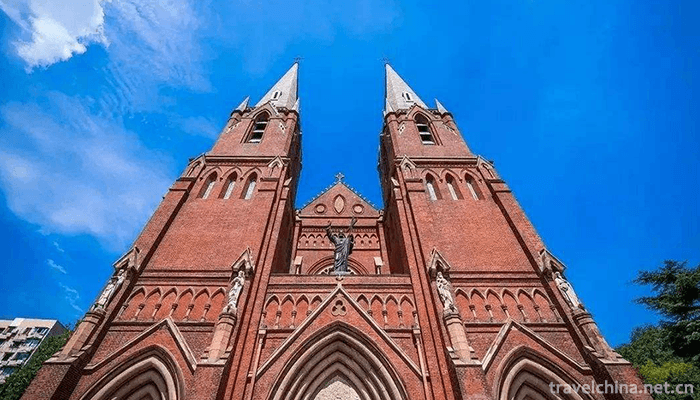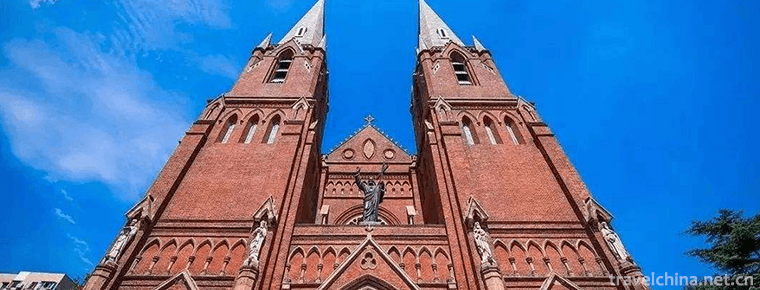Xujiahuiyuan Scenic Area
Xujiahuiyuan Scenic Area
Xujiahuiyuan Scenic Spot is located in Xujiahui, Shanghai Metropolitan Tourism Center Circle. It starts from Wanping South Road, Tianping Road and Huashan Road in the east, links Zhongshan South Road in the south, Triumph Road in the West and Huaihai West Road in the north. It mainly consists of three parts: historical landscape, fashionable and dynamic shopping and green leisure and entertainment.
There are Xujiahui Heavenly Cathedral in the Far East, Xujiahui Observatory in 140 years, the earliest modern library in Shanghai, Xujiahui Public School in China, and other historical buildings.
Characteristic
Introduction and Opening of National 4A Scenic Spot "Xujiahuiyuan"
Visit the Xu Guangqi Memorial Hall in Shanghai, mount the 140-year-old Xujiahui Observatory, and listen to a church concert in Xujiahui Heavenly Cathedral... Xuhui District Tourism Bureau announced yesterday that the Xujiahuiyuan scenic spot where these historic buildings are located has been officially rated as the national 4A-level scenic spot, becoming the first open-type urban tourist attraction in Shanghai.
"These scenic spots form an open scenic spot in an urban community, which is the first in Shanghai." Zhu Jianguo, deputy director of the Regulations Department of Shanghai Tourism Bureau, said that the road of "excavation + opening + standardization" for the establishment of Xujiahuiyuan 4A tourist attraction was an exploration of innovative development of Shanghai's urban tourism.
Historical landscape
Xujiahuiyuan Scenic Spot is located in Xujiahui, the city tourism center of Shanghai. It is a comprehensive humanistic scenic spot which integrates historical buildings, religion, culture, education and other aspects.
There are many well-known and even world-renowned resource entities in the scenic area, known as "living in Shanghai for a hundred years". There are Gothic twin-tower buildings called "the First Cathedral of the Far East". Xujiahui Observatory, which has never interrupted meteorological observation for 140 years, the earliest modern library in Shanghai, "Xujiahui Collection Building" and the earliest residential buildings in Shanghai in the Ming Dynasty. The building "Nanchun Huatang" and the site of the Baidai Company (Xiaohong Lou) where the "Volunteer March" was recorded.
Scenic spot coupon
Xujiahuiyuan Scenic Spot involves many units belonging to different systems, such as churches, schools, libraries and restaurants. In order to coordinate visits, protect the relationship between the daily work of each unit, the scenic spot launched the "appointed visits" model. At the same time, the scenic spot will provide tourists with bicycle rental, free bus and hiking routes.
Tourists can get free "Xujiahuiyuan Tourist Ticket" in the scenic spot visitor center, and visit all the tourist spots free of charge by ticket, or through the official website of the scenic spot, mobile phone client, telephone and other channels, choose different dates and routes for visitor reservation.
At present, special tourist centers have been set up in Xujiahuiyuan scenic spot, and three additional tourist bicycle rental sites have been added in Xuhui Middle School, Guangqi Park and Tushanwan Museum. A series of cultural relics and historic sites have been built between the old site of Xuhui Gongxue, the library, the heavenly cathedral and the observatory to guide tourists to walk around. At the same time, the scenic spot will set up a tourist bus parking lot on the east side of Huashan Road (Guangyuanli plot) and two bus parking spots. In the future, tourist shuttle buses will be provided according to the situation.
It is reported that by the end of this year, the film museum in Xujiahuiyuan scenic area will be built and opened to the public. Next year, the first largest meteorological Museum in China will be rebuilt and completed.
Following the "Xujiahuiyuan" 4A-level urban tourism scenic spot, Shanghai will also build a class A scenic spot group on both sides of the Pujiang River. In the future, tourists can take the Huangpu River cruise on this "flowing" landscape belt for sightseeing, and they can also disembark at any time for sightseeing.
Introduction of scenic spots
Xujiahuiyuan Scenic Spot is located in Xujiahui, Shanghai Metropolitan Tourism Center Circle, east to Wanping Road, south to Puhuitang Road, West to Wending Road and north to Guangyuan West Road. It covers an area of about 2.4 square kilometers. It mainly consists of three parts: historical landscape, fashionable and dynamic shopping and green leisure and entertainment.
The Old Site of Xuhui Public School
Xuhui Public School was founded by Catholic missionary Nanglu in 1850 in Qingdaoguang. It was called the Duke of St. Ina in its early days because it was founded under the patronage of St. Ina Loyola.
Because it is located in Xujiahui, it is also called Xujiahui Public School, or Xuhui Public School for short. It is one of the earliest church schools founded by Catholicism in China.
In 1932, it was renamed Shanghai Private Xuhui Middle School, still sponsored by the Catholic Church; in 1953, it was renamed Shanghai Xuhui Middle School.
The Old Site of Notre Dame
Notre Dame was founded by Jesuit missionary Xue Kong-zhao in Qingpu Hengtang in the 23rd year of Qingdaoguang (1843).
Tongzhi three years (1864) moved to Wangjiatang near Xujiahui. During the seven years of Tongzhi (1868), the Society for the Rescue of the Dead and the Church of Dedication successively established a monastery near the hospitalization of Xujiahui Jesuit, the general name of which was Notre Dame Xujiahui.
The original site is magnificent, and the building was built in 1926. It is the only main part of Notre Dame College of Xujiahui. The building is European style, five-storey reinforced concrete structure. At the end of last century, after the nuns moved to the Tang Tomb Bridge Heavenly Cathedral in Pudong, the building was rented and used by Shanghai Old Station Restaurant. Two train carriages were collected. One was made by German Hanover Vehicle Factory in 1899, and the other was made by Russian Yekaterin Vehicle Factory in 1919.
The Old Site of Baidai Company
No. 811 Hengshan Road is called Baidai Building. Founded in the decade of the Republic of China (1921), it is a three-storey small red building hidden in the green bushes. This is the site of Oriental Baidai Records Company and the birthplace of Chinese records.
Xiao Hong Lou, situated in the South and north, is a three-storey brick-concrete structure. Delicate red flat tiles steep slope roof, all sides of the roof are open with "tiger windows", crimson wood frame exposed, the facade is mainly red brick water wall, white paint between, appear light and agile.
There are balconies on the second floor, open corridors on the bottom, Ioni double columns, white concrete vase railings and ivy stone vases. Mediterranean doors and windows are painted black, narrow and deep, showing the typical French architectural style. There is a cool courtyard in the back of the building, surrounded by tianzhu. A Metasequoia tree in the courtyard looks green and tall, which makes the small building more delicate and lovely in the green shade.
This bright-looking small building has the same distinguished family background. More than eighty years ago, Baidai bought the land and built small buildings on it. From then on, music began to flow here. Soon after, Chinese record labels were born here. The beauty and noble temperament of Baidai small building not only come from its appearance, but also from its historical accumulation.
When the small building was first built, it was cement exterior wall, so the whole building was grey rather than red. The inner passage is about two meters wide, turning up from left to right.
The first floor is the living room for recording and entertaining singers, the second floor is the office for editors, and the third floor is the living room for the owners of Baidai Company. At that time, the reverberation effect of Baidai's studio in Xiaolou was the best in China. It not only uses special double-wall sound insulation, but also sets movable wall surface to adjust reverberation effect according to the change of wall surface, forming different reverberation.
These conditions have attracted many musicians. In the 1930s and 1940s, the name of the small building was often associated with a large number of celebrities in maritime music, such as Zhou Xuan, Li Jinhui, Li Jinguang, Gong Qiuxia, Yao Li, Chen Gexin and Nie Er.
With the change of time, the old "music holy place" hundred generations of small buildings have been used for other purposes. But every Saturday afternoon, in front of the small building, the melody flies and the notes flutter.


-
1.Naturalization TempleSongdan Songzanlin Temple
Kardan Songzanlin Temple is the largest Tibetan Buddhist monastery in Yunnan Province
Time 2018-10-20 -
2.Pavilion of Prince TengTengwang pavilion
Tengwang Pavilion, one of the three famous buildings in the south of the Yangtze River, is located on the East Bank of Ganjiang River along the Yangtze River Road in the northwest of Nanchang City, Ji
Time 2018-12-08 -
3.Leiqiong Haikou Volcanic Group World Geopark
Leiqiong Haikou Volcanic Group World Geopark is located in Shishan Town, southwest of Haikou City. It is only 15 kilometers away from the urban area. The Expressway
Time 2019-01-29 -
4.Big flat tone
Da Ping Diao (also known as Ping Diao, Da You Bang and Da Bang Opera), one of the local traditional operas in Henan and Shandong Province, is one of the national intangible cultural heritage.
Time 2019-04-23 -
5.Sebin Festival of Ewenki Nationality
"Serbin" is an Ewenki language, meaning "happy and peaceful". Sebin Festival is a traditional festival of the Ewenki people. On Sebin Festival, Ewenki hunters gather together
Time 2019-04-28 -
6.Jiali Folk Stories
On May 23, 2011, Jiali Folk Stories were approved by the State Council to be included in the third batch of national intangible cultural heritage list.
Time 2019-05-05 -
7.Jiangnan bamboo
Chinese traditional instrumental music, silk and bamboo, is popular in southern Jiangsu and Zhejiang. After the Revolution of 1911, great progress was made in Shanghai
Time 2019-05-05 -
8.kylin dance
Kirin dance, also known as "Wu" Kirin, is a court dance performance of the Ming Dynasty in China. It was spread among the people when the Nanming Dynasty perished. When dancing,
Time 2019-06-10 -
9.Tang Sancai Techniques
Tang tri coloured firing technique originated from the early Tang Dynasty. The tri coloured glazed pottery of Tang Dynasty, as the essence of traditional Chinese art in the Tang Dynasty, has a history
Time 2019-06-18 -
10.Donghekou earthquake site park
Donghekou earthquake site park, located in Qingchuan County, Guangyuan City, Sichuan Province, is the first earthquake site protection memorial site of Wenchuan earthquake. On November 12, 2008, the opening ceremony and the launching ceremony of the tourism market after the earthquake were held.
Time 2020-11-08 -
11.Meishan landform
Meishan city is high in the West and low in the East, high in the South and low in the north. The territory of mountains and horizontal, hilly ups and downs, dense river network. The central part is the broad Minjiang River valley plain. Guangdongdong mountain in Hongya
Time 2020-12-18 -
12.Yibin secondary industry
In 2019, the total industrial added value of Yibin City is 99.082 billion yuan, an increase of 9.5% over the previous year, and its contribution rate to economic growth is 45.5%. At the end of the year, there were 824 Industrial Enterprises above Designated Si
Time 2020-12-18